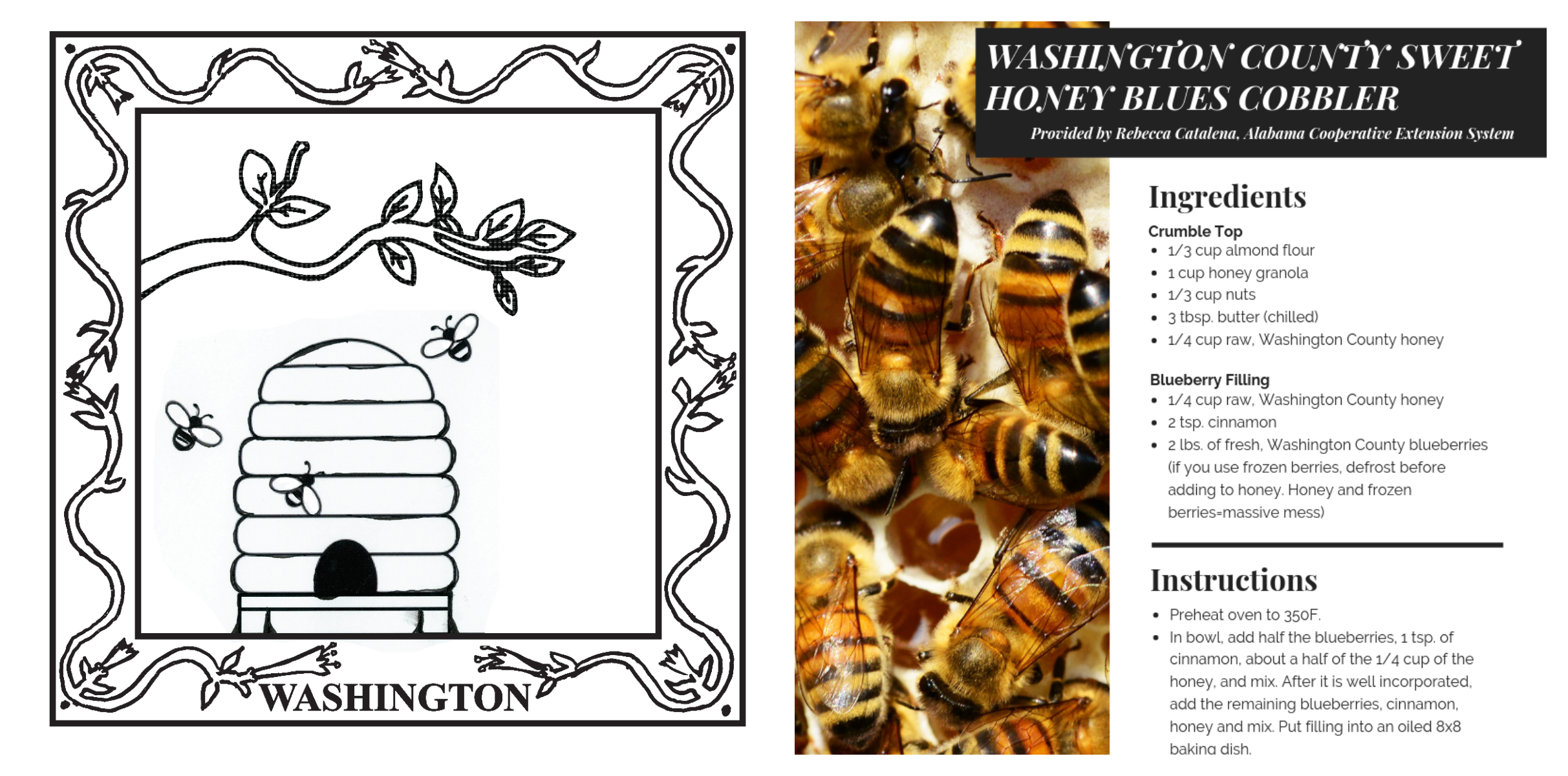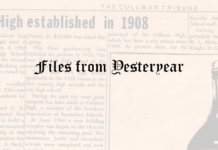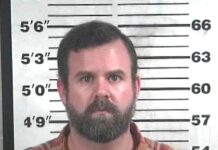The Cullman Tribune is celebrating the Alabama Bicentennial (1819-2019) with statewide field reporting by Alabama Master Gardener/Botanical Artist Ben Johnson South. This year-long feature, "The 67-County Alabama Garden Party," will spotlight different counties each week. Each county will get its own "quilt block," along with a historical profile, and we'll share a recipe specific to the area. At the end of the year, all 67 counties will be put in a book to commemorate the Bicentennial.
First up, Washington County!
The Alabama honeysuckle border on Washington County's quilt block (top left) was inspired by an 18th century, Southern applique quilt.
The United States flag flew over Alabama soil for the first time in Washington County. Our state’s first county was named for America’s first President, himself a passionate plantsman. In 1796, only 20 years after the country’s birthday and a decade before Alabama statehood, a census recorded 190 people, mostly white Europeans with their African slaves, living in Old St. Stephens, the future capital of the territory. For many years, Old St. Stephens was a ghost town; however, within the past decade the historical town has made a comeback! With a newly renovated historical museum and the St. Stephens Historical Park thriving with activities such as disc golf, boating, fishing, camping and horseback riding, it is a must see when visiting the county.
Word of this fertile Eden spread and by 1819, the year Alabama was recognized as a state, there were 500 homes, two hotels, 20 stores and even a theater in that part of Washington County. A newspaper reporter of the time described Old St. Stephens as a hamlet of “elegant, tree-shaded homes.”
When planning your visit, contact St. Stephens Historical Park Director Jennifer Faith (251-247-2622) and check out the calendar of events at www.oldststephens.net.
Washington County, larger than the state of Rhode Island, has plant-centric place names with communities called: Fruitdale, Sunflower, Yellow Pine and even Vinegar Bend. This is Alabama’s “Piney Woods” region. Timber and pulp are still important revenue producers. The county’s major industry today, in part embraced because of crop devastation by boll weevils, is petrochemical, rooted in plant culture. Green is a favorite color in this part of the state and that’s because of pine needles, cotton plants, truck farming and the money they have generated.
Before the white settlers, this part of Alabama was farmed by Choctaw and Creek Indians. Many escaped the federal government’s Indian removal during the 1830s by hiding in the deep forests between present-day Washington and Mobile counties. Their descendants are the MOWA tribe of Choctaw prominent today in the region. I encourage you to visit the interesting and educational MOWA Cultural Center in Washington County’s Mt. Vernon community.
Now try this for a quintessential, Washington County, PLANTS + PEOPLE, Bicentennial story. Surrounded by the cotton fields his family worked, a boy named Jimmy Roberts was born with a brittle bone disease. He’s 73 now, but in his words, “he’s never taken the first step.” Jimmy’s mother died before he was 6 years old and he was raised near Chatom by his father’s people. His grandmother taught him to sew cotton quilt tops with a needle and thread and he made and sold these for $3 and his aunt quilted them with cotton batting for an additional $3.50. So, for $6.50 local folks bought a handsewn, fine quality, cotton quilt. Talking with Jimmy Roberts is like a Harper Lee story come to life. With his quilt business earnings, Jimmy bought an old, wooden, “honky-tonk” piano and has played for Alabama gospel quartets, like The Journeymen, for decades. He also worked in the Washington County pajama factory, military uniform manufacturing and other textile plants. This man is proud to tell you he’s “never taken a dime of charity” in his life. He still sews. Jimmy Roberts is a pastor of a church, but he “takes in” alterations, and he fashions wedding and prom gowns and bespoke baby clothes. Show him a photograph of some fancy design and Mr. Jimmy can conjure it into reality. In fact, he’s making me a bowtie for the “Alabama Garden Party,” and he’s up for making Gov. Kay Ivey anything she wants for the Bicentennial celebration. Governor Kay just needs to send Mr. Jimmy a picture.
Here are some other pleasurable examples of how PLANTS + PEOPLE intersect in Washington County, including a scrumptious recipe for WASHINGTON COUNTY SWEET HONEY BLUES COBBLER, which salutes local beekeepers and local blueberry growers:
— FARMERS’ MARKET: Every Friday in Chatom from May to Thanksgiving, sponsored by Washington County office of Alabama Cooperative Extension System
— LOCALLY-OWNED PLANT NURSERIES: Williams Nursery in Leroy and Pine City Lawn and Garden, also in Leroy
— BEST PERSPECTIVE FOR LANDSCAPE PHOTOGRAPHY: Old St. Stephens Historical Park combines natural beauty and local history (suggested by Sabra Johnson, Washington County Coordinator, Alabama Cooperative Extension System)
–LOG CHURCH: Andrews Chapel in McIntosh; this square-logged building with square-notched corners and a wood shingle roof was begun in 1860.
–PLANTING AN IDEA: Washington County gardeners have an interest in the Alabama Master Gardener program which can in part be taught via the Zoom teleconferencing network of the Alabama Cooperative Extension System; maybe connect with local beekeepers and have a honey-tasting to create some buzz and explore this sweet idea.
Y’ALL COME to Washington County on your “67-COUNTY, ALABAMA GARDEN PARTY” tour. It’s where Alabama history began and a very good place to start your own celebration of some mighty fine “PLANTS + PEOPLE.” Many thanks to Sabra Johnson and Rebecca Catalena of the Alabama Cooperative Extension System for their help on this Bicentennial salute. Their website is http://offices.aces.edu/Washington. For up-to-date info on events and workshops check their Facebook page at Washington County – Alabama Extension.
WASHINGTON COUNTY SWEET HONEY BLUES COBBLER—(provided by Rebecca Catalena, Alabama Cooperative Extension System)
INGREDIENTS:
Crumble Top:
1/3 cup almond flour
1 cup honey granola
1/3 cup nuts
3 tbsp. butter (chilled)
1/4 cup raw, Washington County honey
Blueberry Filling:
1/4 cup raw, Washington County honey
2 tsp. cinnamon
2 lbs. of fresh, Washington County blueberries (if you use frozen berries, defrost before adding to honey. Honey and frozen berries=massive mess)
INSTRUCTIONS:
Preheat oven to 350 F.
In bowl, add half the blueberries, 1 tsp. of cinnamon, about a half of the 1/4 cup of the honey, and mix. After it is well incorporated, add the remaining blueberries, cinnamon, honey and mix. Put filling into an oiled 8×8 baking dish.
In a food processor, combine all the crumble top ingredients. Blend well.
Crumble topping ingredients over the top.
Bake for 25-35 minutes or until fruit is tender and topping is browned. If browning starts too soon, cover the top with aluminum foil while fruit continues to bake.
Enjoy alone or add a scoop of vanilla ice cream.
Also, check out Alabama Bicentennial: 200 ways to save Alabama for the next 200 years.
Copyright 2019 Humble Roots, LLC. All Rights Reserved.























